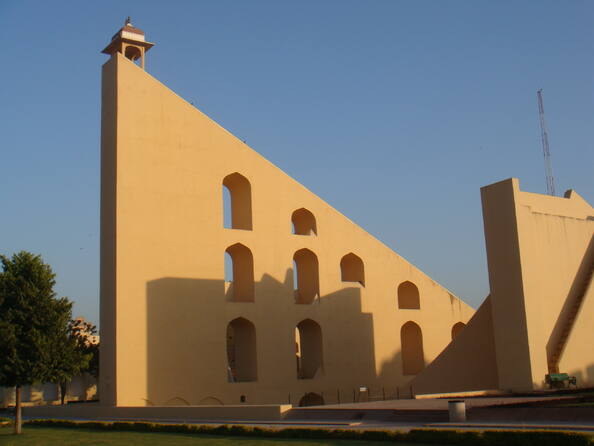简塔•曼塔天文台
The Jantar Mantar, Jaipur
The Jantar Mantar, in Jaipur, is an astronomical observation site built in the early 18th century. It includes a set of some 20 main fixed instruments. They are monumental examples in masonry of known instruments but which in many cases have specific characteristics of their own. Designed for the observation of astronomical positions with the naked eye, they embody several architectural and instrumental innovations. This is the most significant, most comprehensive, and the best preserved of India's historic observatories. It is an expression of the astronomical skills and cosmological concepts of the court of a scholarly prince at the end of the Mughal period.
Description is available under license CC-BY-SA IGO 3.0
Jantar Mantar, Jaipur
Le Jantar Mantar de Jaipur est un site d'observation astronomique construit au début du XVIIIe siècle. Il comprend un ensemble d'une vingtaine d'instruments fixes. Edifiés en maçonnerie, ce sont des exemplaires monumentaux d'instruments connus mais souvent aux caractéristiques particulières. Destinés à des observations d'astronomie à l'œil nu, ils comportent plusieurs innovations architecturales et instrumentales. C'est l'ensemble le plus significatif, le plus complet et le mieux conservé des observatoires anciens de l'Inde. Il exprime les compétences astronomiques et les conceptions cosmologiques acquises dans l'entourage d'un prince savant à la fin de l'époque moghole.
Description is available under license CC-BY-SA IGO 3.0
جانتار مانتار، في مدينة جانيبور
إن جانتار مانتار، في مدينة جانيبور، هو موقع للرصد الفلكي أنشئ في بداية القرن الثامن عشر. ويشمل هذا الموقع مجموعة مؤلفة من نحو عشرين آلة ثابتة. وتضم هذه الآلات المبنية عدة ابتكارات معمارية وآلية. ويُعتبر الموقع أهم وأكمل مجموعة من المراصد القديمة تمت المحافظة عليها جيداً في الهند. وهو يشهد على الكفاءات الفلكية والتصورات الكونية التي اكتسبتها حاشية أمير علّامة هو ساواي جاي سينغ الثاني، وذلك في نهاية الحِقبة المغولية. كما أن هذا الموقع يُعد مجالاً لتلاقي الثقافات الإسلامية والهندية فيما بين علماء الفلك والمنجمين.
source: UNESCO/CPE
Description is available under license CC-BY-SA IGO 3.0
简塔•曼塔天文台
印度斋浦尔的简塔•曼塔天文台建成于18世纪初,建筑为砖石结构。天文台内建有一组由20多个主要固定装置构成的观测设备。它们是已知观测装置中的不朽杰作,并在许多方面有着自身的特点。简塔•曼塔天文台为用肉眼进行天文观测而设计,其建筑和装置都采用了不少创新设计。它是印度最重要、最全面、保存也最完好的古天文台,展现了印度莫卧儿时代末期对宇宙的认知以及探究天文学的能力。
source: UNESCO/CPE
Description is available under license CC-BY-SA IGO 3.0
Джантар Мантар
Джантар Мантар в Джайпуре - это астрономическая обсерватория, построенная в начале восемнадцатого века. Она включает около двадцати стационарных инструментов наблюдения. Сделанные из кирпича, ее инструменты обладают непреходящей итсорической ценностью. Сконструированные для астрономических наблюдений невооруженным глазом, они отличаются множеством технических и архитектурных новшеств. Все это делает ее самой мощной, полной и наиболее сохранившейся из старинных обсерваторий Индии. Она свидетельствует о высоком уровне развития астрономической науки и знаниях в области космологии, получивших распространение в окружении просвещенного князя Савай Джай Сингх II, правившего в конце эпохи Великих Моголов.
source: UNESCO/CPE
Description is available under license CC-BY-SA IGO 3.0
Jantar Mantar de Jaipur
Construido a principios del siglo XVIII, el Jantar Mantar de Jaipur es un observatorio astronómico integrado por unos veinte instrumentos en obra de albañilería que fueron innovadores en su tiempo, tanto en el plano arquitectónico como técnico. Destinados a observaciones astronómicas a simple vista, comportan varias innovaciones arquitectónicas e instrumentales. Se trata del conjunto de observatorios antiguos más significativo, más completo y mejor conservado de la India. El Jantar Mantar es un fiel reflejo de las concepciones cosmológicas y los conocimientos astronómicos de los sabios que agrupó en torno un marajá ilustrado que vivió a finales de la era mogol.
source: UNESCO/CPE
Description is available under license CC-BY-SA IGO 3.0
ジャイプールにあるジャンタール・マンタール
ジャイプールにあるジャンタール・マンタールは、18世紀初めに建てられた天文観測所である。その中の20の主要施設は、機器類が石造のモニュメントのようにつくられており、それぞれが機器そのものの固有の特徴を表している。裸眼で天体の位置を観測できるように設計され、機器としても、建築の面でも新機軸を具体化したものである。これらは、インドの歴史的天文台の中で最も重要かつ総合的施設で、保存状態も非常によい。ムガール帝国時代末期の学者肌の王子の宇宙観をもとに、当時の天文学的技術をもとにつくられたものである。source: NFUAJ
Jantar Mantar, Jaipur
De Jantar Mantar in Jaipur is een astronomische observatieplaats, gebouwd aan het begin van de 18e eeuw. De plek bevat een set van ongeveer 20 belangrijke, stationaire observatie-instrumenten. Het gaat hier om monumentale voorbeelden van metselwerk van bekende instrumenten, met in veel gevallen specifieke eigenschappen. De instrumenten belichamen een aantal architectonische en instrumentale innovaties omdat ze ontworpen waren voor observatie van astronomische posities met het blote oog. Jantar Mantar is het meest uitgebreide en best bewaarde observatorium van alle historische observatoria in India. Het toont de astronomische vaardigheden en kosmologische concepten aan het hof van een academische prins aan het einde van de Mogol periode.
Source: unesco.nl
जंतर मंतर, जयपुर
जयपुर में जंतर मंतर 18 वीं शताब्दी की शुरुआत में बनाया गया एक खगोलीय प्रेक्षण स्थल है। इसमें लगभग 20 मुख्य उपकरणों का एक सेट शामिल है। वे ज्ञात उपकरणों की राजगीरी के स्मारक हैं, लेकिन कई मामलों में उनके अपने स्वयं के विशिष्ट लक्षण भी हैं। इन्हें नग्न आंखों से खगोलीय अवस्थाओं के अवलोकन के लिए बनाया गया है, जिनमे कई स्थापत्य और वाद्य नवाचारों को अपनाया गया है। यह भारत की ऐतिहासिक वेधशालाओं में सबसे महत्वपूर्ण, सबसे व्यापक और सबसे अच्छी तरह से संरक्षित है। यह मुगल काल के अंत में एक विद्वान प्रिंस के दरबार के खगोलीय कौशल और ब्रह्मांड संबंधी अवधारणाओं की अभिव्यक्ति है।
Source: India
